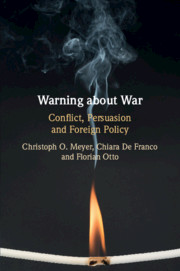Book contents
- Warning about War
- Warning about War
- Copyright page
- Contents
- Figures
- Tables
- Acknowledgements
- Chapter 1 Conflict Warnings as Persuasion Attempts
- Chapter 2 A Theory of Conflict Warning as Persuasion in Foreign Policy
- Chapter 3 Inside-Up Warnings within States and International Organisations
- Chapter 4 Outside-In Warnings
- Chapter 5 Outside-In Warnings
- Chapter 6 (Mis-)identifying Warnings and the Problem of Hindsight Bias
- Chapter 7 What Makes Individual Officials Persuasive Warners?
- Chapter 8 Explaining Differences in Persuasiveness
- Chapter 9 Warning within EU Institutions and the Ukrainian-Russian Conflict of 2013–2014
- Chapter 10 When Are Warnings Heeded and What Can Warners Do?
- References
- Index
- References
References
Published online by Cambridge University Press: 23 August 2019
- Warning about War
- Warning about War
- Copyright page
- Contents
- Figures
- Tables
- Acknowledgements
- Chapter 1 Conflict Warnings as Persuasion Attempts
- Chapter 2 A Theory of Conflict Warning as Persuasion in Foreign Policy
- Chapter 3 Inside-Up Warnings within States and International Organisations
- Chapter 4 Outside-In Warnings
- Chapter 5 Outside-In Warnings
- Chapter 6 (Mis-)identifying Warnings and the Problem of Hindsight Bias
- Chapter 7 What Makes Individual Officials Persuasive Warners?
- Chapter 8 Explaining Differences in Persuasiveness
- Chapter 9 Warning within EU Institutions and the Ukrainian-Russian Conflict of 2013–2014
- Chapter 10 When Are Warnings Heeded and What Can Warners Do?
- References
- Index
- References
Summary

- Type
- Chapter
- Information
- Warning about WarConflict, Persuasion and Foreign Policy, pp. 284 - 304Publisher: Cambridge University PressPrint publication year: 2019



